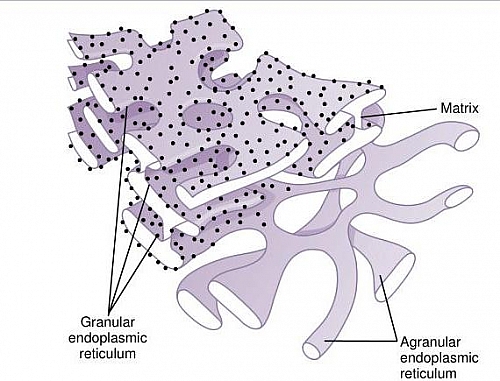Endoplasmic Reticulum (ER) is found in the cytoplasm of most cells and forms a system of membranes. The membranes form the boundaries of channels that may be arranged in the form of flattened sacs (or cisternae) or of tubules. Because of the presence of the Endoplasmic Reticulum, the cytoplasm is divided into two components: one within the channels and one outside them. The cytoplasm within the channels is called the Vacuoplasm, and that outside the channels is the Hyaloplasm or Cytosol. Substances formed in some parts of the cell enter the space of the endoplasmic reticulum and are then conducted to other parts of the cell. Also, the vast surface area of this reticulum and the multiple enzyme systems attached to its membranes provide machinery for a major share of the metabolic functions of the cell.
Table of Contents
- Endoplasmic Reticulum Definition
- What is Endoplasmic Reticulum?
- Who discovered Endoplasmic Reticulum?
- Endoplasmic Reticulum Function (What does the Endoplasmic Reticulum do?)
- Endoplasmic Reticulum Diagram
- Endoplasmic Reticulum Structure
- Types of Endoplasmic Reticulum
- Difference between Rough and Smooth Endoplasmic Reticulum
Endoplasmic Reticulum Definition
Endoplasmic reticulum (ER) is a network of tubular and microsomal vesicular structures which are interconnected with one another. It is covered by a limiting membrane which is formed by proteins and bilayered lipids. This complex three dimensional internal membrane system of flattened sheets, sacs and tubes plays an important role in making proteins and shuttling cellular products.
What is Endoplasmic Reticulum?
Endoplasmic is gotten from the words: Endo which means “within the plasm” and Reticulum which means “network“. The endoplasmic reticulum therefore is a network of double-layered semipermeable membrane found in the Cytoplasm of cells that is normally branched but may occur in parallel. The membrane of endoplasmic reticulum is continuous with the nuclear membrane and that of the cell membrane too. Chemically the membrane of Endoplasmic reticulum is made by lipoprotein and some small granular bodies may be present on it (when these proteins are present, this type of ER is called Rough Endoplasmic Reticulum).
Who discovered Endoplasmic Reticulum?
The endoplasmic reticulum was first discovered with the light microscope in 1897 by Garnier who named it as Ergastoplasm but the membranes of the Endoplasmic reticulum where later discovered in 1945 by use of the electron microscope by three scientists namely: Keith R. Porter,Albert Claude, andErnest F. Fullam
Endoplasmic Reticulum Function (What does the Endoplasmic Reticulum do?)
- Endoplasmic reticulum is involved in metabolisms of Fats and the production of various materials
- Endoplasmic reticulum form the skeleton of protoplasm.
- Protein synthesis occurs in rough endoplasmic reticulum.
- Lipid, some different hormones, glycogens etc. are synthesized in the smooth endoplasmic reticulum.
- Endoplasmic reticulum also plays the role of internal carrier of lipid and protein.
Endoplasmic Reticulum Diagram
The cross sectional diagram of Endoplasmic reticulum shows their appearance as a series of maze-like channels that are often closely associated with the nucleus.
Endoplasmic Reticulum Structure
The Endoplasmic reticulum is a network of tubular and flat vesicular structures in the cytoplasm The lumen of endoplasmic reticulum contains a fluid medium called endoplasmic matrix. The diameter of the lumen is about 400 to 700 Angstrom. The total surface area of the network of ER structure in some cells such as the liver cells can be as much as 30 to 40 times the cell membrane area.
When ribosomes are present, the rough Endoplasmic reticulum attaches polysaccharide groups to the polypeptides as they are assembled by the ribosomes. Smooth Endoplasmic reticulum, without ribosomes, is responsible for various activities, including the synthesis of lipids and hormones, especially in cells that produce these substances for export from the cell.
Types of Endoplasmic Reticulum
Endoplasmic reticulum is of two types: Rough endoplasmic reticulum and Smooth endoplasmic reticulum. Both the types are interconnected and continuous with one another and depending upon the activities of the cells, the rough endoplasmic reticulum changes to smooth endoplasmic reticulum and vice versa. Products synthesized by the ER are stored in the channels within the reticulum. Ribosomes and enzymes, are present on the outer surfaces of the membranes of the reticulum.
A modified endoplasmic reticulum called the sarcoplasmic reticulum, plays an important role in skeletal and cardiac muscle; in particular, the sarcoplasmic reticulum can sequester Calcium ions and allow for their release as signaling molecules in the cytosol.
Rough Endoplasmic Reticulum Function and Structure
Rough endoplasmic reticulum (also called Granular reticulum) has characteristic bumpy appearance due to the multitude of ribosomes coating the surface. It is the site where proteins not destined for the cytoplasm are synthesized.
Smooth Endoplasmic Reticulum Function and Structure
Smooth endoplasmic reticulum is the endoplasmic reticulum with smooth appearance. It is also called Agranular reticulum and is formed by many interconnected tubules. The smooth endoplasmic reticulum is also called Tubular endoplasmic reticulum. Smooth endoplasmic reticulum provides a variety of functions, including lipid synthesis and degradation, and calcium ion storage. In liver cells, the smooth Endoplasmic reticulum is involved in the breakdown of toxins, drugs, and toxic byproducts from cellular reactions.
Difference between Rough and Smooth Endoplasmic Reticulum
- Rough endoplasmic reticulum has numerous ribosomes on its surface, whereas smooth endoplasmic reticulum has no ribosomes.
- Proteins are synthesized by the ribosomes on the rough endoplasmic reticulum while lipids are synthesized by the smooth endoplasmic reticulum.
- The rough endoplasmic reticulum gets its name from its granular or rough appearance under magnification, which is attributable to the presence of ribosome while the smooth endoplasmic reticulum does not have ribosomes attached to it, giving it a smooth appearance.

